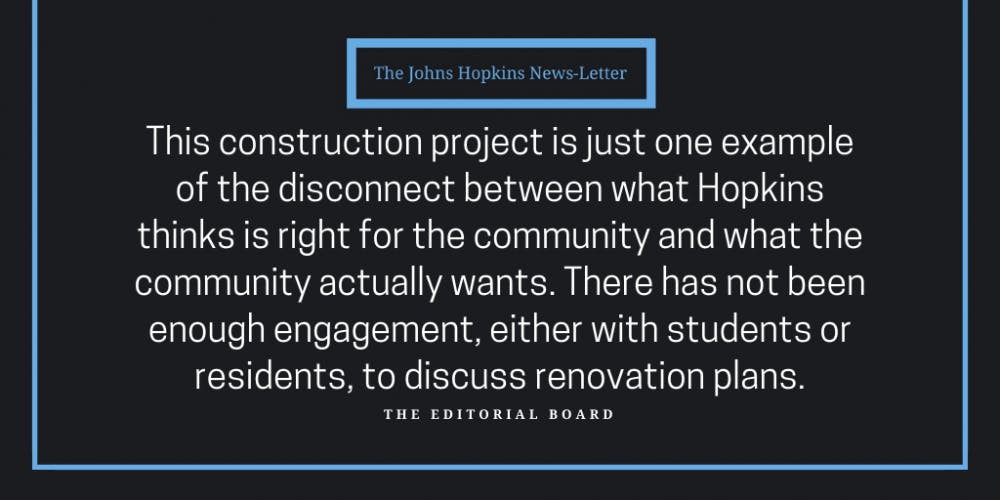We all see the construction along Saint Paul Street: It’s loud, imposing and causes us to reroute our walk across the neighborhood. The construction, part of the University’s Charles Village Streetscape Project, has made its way up the street since March and won’t conclude until December.
The construction’s impact on students has been minimal. It has more of an effect, however, on residents and business owners.
Earlier this year, a Charles Village community member sent an email to University President Ronald J. Daniels and The News-Letter about the development along Saint Paul Street. The community member, who is also a Hopkins employee, expressed concern about the “lengthy, loud, and extremely disruptive” construction and its effects on quality of life and local businesses.
They described a conversation with Carma Halterman, the owner of Carma’s Café, one of their favorite local establishments. The owner expressed that there had been monetary strain on the business. The construction has damaged their sales, and for the first time in over a decade, Carma’s is looking at closure.
Johns Hopkins Facilities & Real Estate announced the project the week construction began. The project is designed to improve pedestrian safety and involves laying brick crosswalks and improving lighting fixtures.
According to Vice President for Facilities & Real Estate Robert McLean, the University has been working with the Charles Village Civic Association (CVCA), the Charles Village Business Association and the North Charles Village Planned Unit Development Design Review Committee for the past five years of the planning phase. A project management committee was also established.
Eddie’s Market owner Jerry Gordon said that while there was an initial downfall in sales when a fence was erected in front of the store, his business has since bounced back. He also said that Hopkins was great with communication and support. Halterman, on the other hand, told The News-Letter that Hopkins was terrible about being transparent and that sales dropped over 30 percent at times.
We question how the businesses could have such different experiences, located only a block apart. Eddie’s, it turns out, is a member of the CVCA while Carma’s is not. This membership status may have affected the extent of communication between Hopkins and the various Charles Village businesses. University engagement, however, needs to go beyond members of these associations.
Furthermore, it is unclear to us if Hopkins ever took the opinions of neighborhood residents into account. The avenues of community feedback remain murky, and who exactly has a voice in these conversations is ambiguous as well.
This construction project is just one example of the disconnect between what Hopkins thinks is right for the community and what the community actually wants. There has not been enough engagement, either with students or residents, to discuss renovation plans. It seems that those who want their opinion on Hopkins construction to be taken into account must hope to be included in the University’s project management committee.
Of course, the school ultimately decides how it will spend its money. But community members should have the right to express their opinions on changes that have a direct impact on them, especially when the University is acting in spaces where non-Hopkins affiliates live and work.
Charles Village Streetscape is not the first construction project that Hopkins has worked on in recent years. Homewood campus is constantly undergoing renovations, and the University announces new projects as soon as others are completed.
The upcoming Student Center, announced in March, will replace the Mattin Center and will be open to students as well as community members. In addition to the Saint Paul construction, the University will transform the Blackstone apartment building into a hotel. Called the Study at Johns Hopkins, the hotel will feature 115 rooms, a restaurant and meeting spaces, all of which are planned to open in the summer of 2021.
As both students and residents of Baltimore, we understand why the University is undertaking the Charles Village Streetscape project and the Student Center development. Both of these projects come after years of planning and a genuine desire to improve the residential experience and student life. In the decision to transform the Blackstone, however, we believe that Hopkins is acting without the community’s best interests at heart.
We are confused as to why the Study, a hotel, needs to replace the Blackstone, a residential apartment building. In an announcement from Mitch Bonnaro, the University’s chief real estate officer, he explained that more hotel space is needed directly by Homewood Campus “to accommodate visitors from around the world.” But why does that space need to remove one of the most affordable off-campus housing options, located closer to campus than most other apartment buildings and rowhouses? Is the Hilton Doubletree, another hotel along University Parkway, not enough to accommodate visitors?
The University’s announcement about the Study project also came as an unwelcome surprise. Residents from the Blackstone found out that they could not renew leases for future years on the same day that the news broke to the public. They now have to begin the search for new apartments, weeks after applications for leases in other residences opened. We are surprised that Hopkins chose not to notify residents of the building earlier.
We wonder who Hopkins is really building these projects for. Do students want a Student Center that will leave them without a home for the arts on campus during the construction? Chief Real Estate Officer Mitch Bonanno claims the hotel will serve the needs of the community. However, how can the hotel serve the community when it primarily caters to non-residents and its developer is based in New York?
As Eddie’s Market owner Jerry Gordon said to The News-Letter, “It's going to be a very beautiful area and I think people will be very proud to be part of our Charles Village.” We believe that the neighborhood will be beautiful, and we are proud to be part of this community. But going forward, the University must do a better job of engaging with students and residents alike before making changes to the landscape of our neighborhood.





